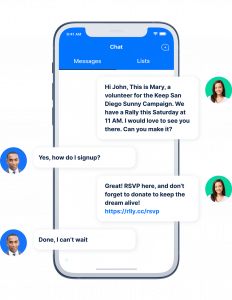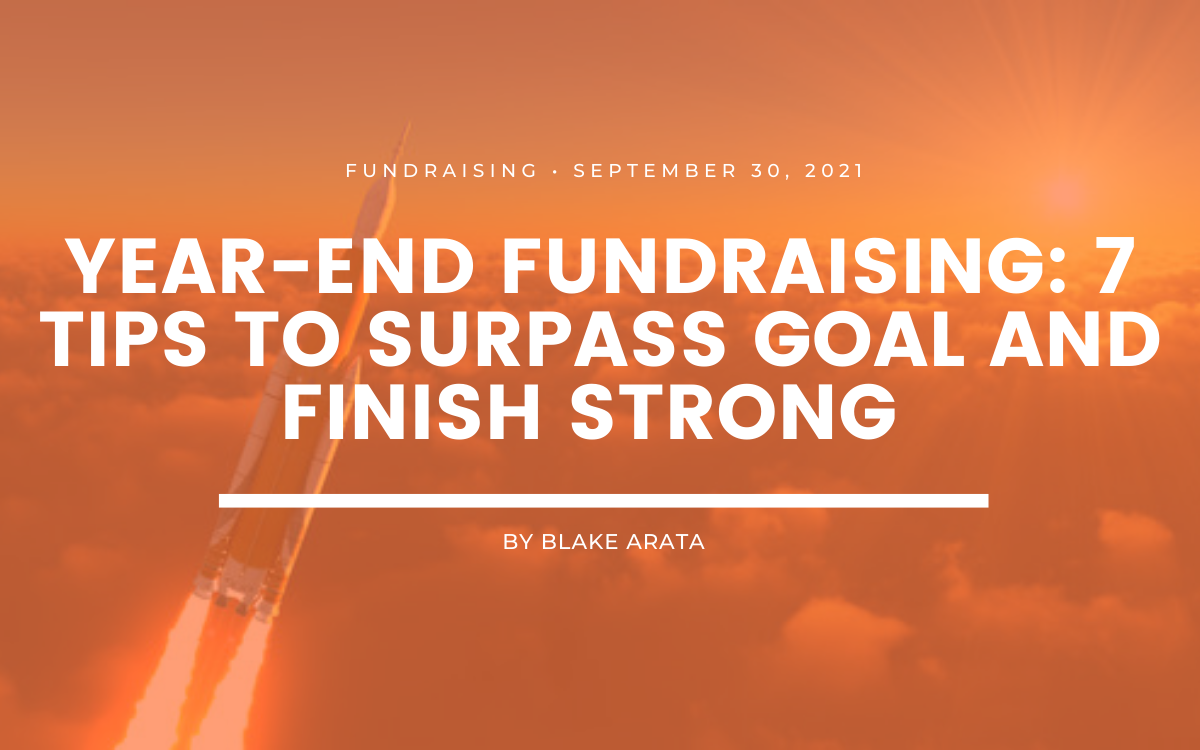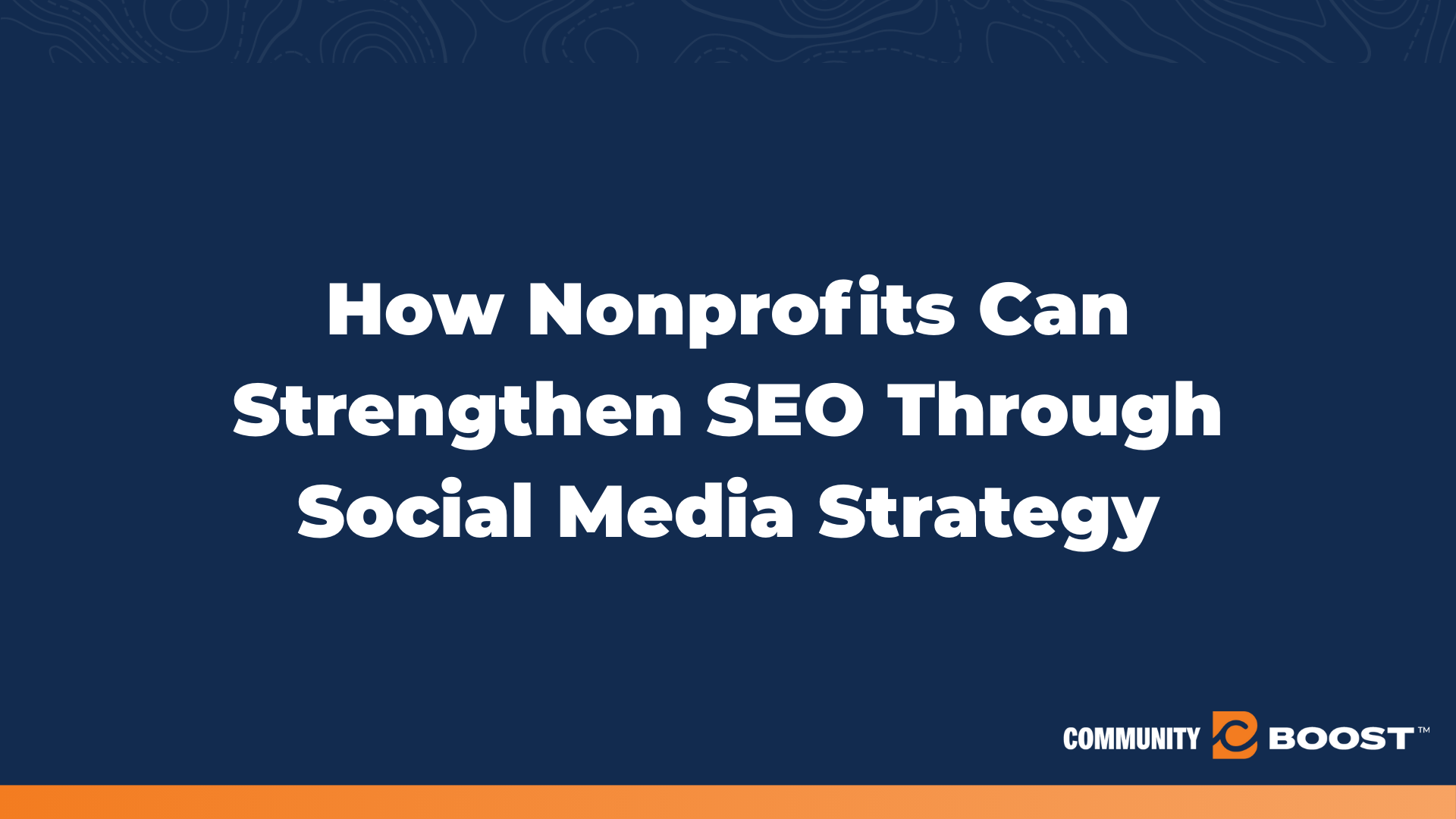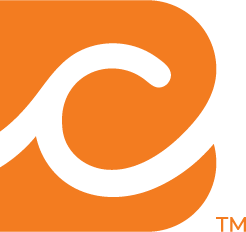Year-End Fundraising Campaign: 7 Tips to Surpass Goal and Finish Strong
7.5 min to read ✭ Learn how to take your year-end fundraising campaign to the next level with these basic tips that every nonprofit can implement.
Tip #1: Don’t Reinvent The Wheel
As a nonprofit, it can be hard to recognize your year end fundraising campaign wins when you are feeling overwhelmed as if everything is coming down on your plate at once, and you are wearing ALL of the hats. If you don’t feel that way then great! And we need to connect to learn your strategies. However, this may be the most important time to hone in on your past wins and use them as a roadmap to success.
To do this, we suggest asking questions that will help you build a data-driven year-end giving strategy and help benchmark/track the right metrics for future year-end campaigns. Get out your notepad!
- What was your average gift amount last year?
- What was the average cost per donor (on the advertising front)?
- What campaigns raised the most money?
- What were the most popular campaigns with each donor segment?
- Were the campaigns run through your website or a separate fundraising page? What were the pros and cons of both?
- Which channels were the highest converting (email, direct mail, paid social, Google Ad Grant, etc.)?
Now that you have a scope on your past wins, we want to share our key takeaways from 2021:
- We have data on which days we saw the most engagement with our digital advertising – this will be crucial to help us decide which days we want to scale our spend for 2021.
- We know that the majority of our impressions and conversions came from mobile campaigns so we will be doubling down on MOBILE ONLY campaigns for year-end. Think about utilizing text messaging campaigns with Rally Corp. Text-2-donate, Text-2-Pledge, and Text-2-RSVP to make donor acquisition easy.
- We used Fundraise Up to help us better track and segment out the types of donors coming to the site. We saw that those that gave during Giving Tuesday (1-time donors) often became recurring givers during year-end through tailored Facebook advertising. This is easy to do with Facebook events, and something we want to capitalize on this year.
- We found that early top-of-funnel campaigns were helpful for remarketing traffic. Advertisers will need to rely on video engagement campaigns this year
Here is another question to answer in your notes:
Have you used Facebook advertising for your year-end campaigns? If you have, do you have your goals separated out for each step of the funnel?
Tip #2: Engage with Donors Well Before Year-End
It’s true, the earlier the better. Don’t wait too long to re-engage with your donors! We like to say that your donors aren’t YOUR donors. One way to encourage early interaction is by launching relational texting campaigns. With open rates well over 90%, texting is one of the most effective channels today. Use RallyCorp’s interactive texting platform:

Because of Giving Tuesday and YE saturation, it is more important than ever to warm up different audiences to year-end appeals ahead of time. This helps to keep donors informed, engaged with the mission, and expecting your advertisements.
Having multiple touchpoints to ensure supporters feel involved year-round is ????. Also, remember that donor stewardship isn’t one-size-fits-all. You should consider a personalized approach for your outreach strategy based on each donor segment (top givers, recurring givers, new donors, volunteers).
To help you out a bit, here is the exact timeline we use for all of our clients:
September
- Repost the year’s most successful content.
- Highlight the year’s biggest achievements.
- Start creating and testing content so it’s ready in time for the holidays.
- Create and test posts and other content that will engage potential new supporters.
October
- Tweak the tests you began in September.
- Start testing ads
- Continue to engage and attract users with regular posts.
November
- Increase posts and promotion on Facebook.
- Highlight key giving events for the weeks ahead.
- Launch your #GivingTuesday campaign.
- Showcase the impact made, people helped, the volunteers who make it possible.
- Thank you campaign for donors & volunteers.
December
- Encourage your supporters, board members, and volunteers to use Facebook Fundraisers on your behalf.
- Make sure to push for a matching gift if possible!
Tip #3: Use Segmentation and Personalization
If you haven’t heard this before, PEOPLE PREFER PERSONALIZATION! It is so important to craft a message that is for your actual supporters. You can do this by dividing your donors into groups based on their behaviors and traits. They should feel like they are in your shoes and that the message is meant for them. Use your existing data to make your appeal sound like it was written just for that individual.
To personalize ads, focus on delivering timely and relevant messaging that is segmented by visitor traffic. The best-performing campaigns stand out by having one message that is concrete, specific, and consistent across channels like Instagram, Facebook, and Youtube. By combining this practice with machine learning to dynamically select ad formats, creative, and copy, we can improve user experience by meeting people where they’re at. This is available for Google and Facebook advertising.
*An example for a nonprofit would be a dynamic ad for those that are cold traffic, a dynamic ad for those that checked out but abandoned, and another for those that have donated in the last 30-days.
Tip #4: Measure What Matters
Allow data to be at the center of your strategy and set yourself up for success by identifying these clear metrics that you want to keep an eye on before launching a campaign:
Fundraising: Number of gifts, average donor amount, the average cost per donor, donor retention rate, total funds raised. If using advertising tools, add in donor data!
Marketing: Conversion rate, ROAS, ROI, landing page views, bounce rate, cost per conversion, frequency.
Project or program: Number of beneficiaries served, beneficiary satisfaction rate, number of hours per project
Instead of measuring transactions alone, model the lifetime value you derive from your supporters and value the best ones. To do this, find out what’s working in your marketing and what’s not and identify the role of each touchpoint along the customer’s journey. What are your abandonment rates and what causes page drop-off?
To find out what works and what doesn’t, test! Always be testing, using controlled experimentation to understand what happened because of one marketing spend change. By combining all of these strategies, you can improve campaign effectiveness, get the credit you deserve for your programs and, most importantly, ensure a better return on investment for all of your marketing.
Here is our measuring checklist to make this easier for you:
- Test your website through Google Tag Manager
- Test your tracking through Google Tag Manager
- Test all of your marketing funnels prior to launching your campaigns
- Put your year-end giving campaign front and center on your website. If you want to test, you can use Google Optimize to A/B test different versions of your year-end campaign messaging (depending on who is reaching you). For instance, you may want to show one version to cold traffic and another version to returning visitors or past givers.
- Additional tip: Use Google PageSpeed insights to see if your site is mobile-optimized (60% of nonprofit site visitors are on mobile). You can also use this tool to check site speed and for diagnostics on how to improve your site.
Tip #5: Capitalize on the Last 3 Days of the Year
Nonprofit organizations receive a whopping 50% of their annual donations during the last three months of the year (October, November, and December) and 12% of all annual donations occur during the final three days of the year (December 29, 30, and 31). Also, ⅓ of all nonprofit spending occurs in December.
The highest return on ad spend starts with Search ads ($3.59), followed by Display ($.73) and then Paid Social ($.70).
What we are trying to say is, it’s time to scale! Ask yourself how your nonprofit should scale this year-end and then take 5 minutes to map out the channels you want to advertise on this year, and what your estimated budget will be.
Tip #6: Lean Into Recurring Giving
The most important thing here is to not be afraid to target those who have already donated. Why? Because of all one-time donors that return to start a recurring gift subscription:
- 25% proceeded to make another one-time gift
- 11% made a donation to a crowdfunding campaign
- 14% signed up to fundraise or registered to a fundraising campaign
- 10% participated in a peer-to-peer campaign
Strong recurring giving is game-changing and it’s all in the timing. Start early! The majority of Giving Tuesday donors do not return until the next holiday season, but 31% of those who do return for a 2nd gift do so within 6 months. That’s why it is important for nonprofits to reactivate sooner and be more creative in the ways you are reaching out. You might want fast donation checkouts, but the people that spend 4 to 5 minutes on the campaign pages, convert more!
If you are in need of recurring gifts, be straightforward about it. It seems simple, but just explaining the difference between a one-time gift from a recurring gift for your nonprofit organization can be enough to onboard recurring givers. You want to really emphasize the benefit there for the donor and you! You can explain that it’s more convenient to donate through an automated recurring program, it helps them stay connected with the organization and know where their money is going, and they can give small monthly gifts instead of one large gift. By building a community around your program, people may be more inclined to join on the bandwagon.
If you don’t currently have the option of recurring giving, consider moving to a giving experience platform that makes recurring giving payments easy and straightforward for your supporters and easy to implement for you.
Tip #7: Lead with Video
Here at Community Boost, we like to say that video is king! Video ads visually create an emotional connection, it’s a great way to diversify your marketing mix, and it helps with iOS tracking.
Due to iOS14 updates, it’s gotten harder to track users on-site. You can no longer rely on normal remarketing tracking through pixels. Combatting this by using a highly engaging video as brand awareness or post-engagement tool allows advertisers to build bigger remarketing pools using 1st party data.
Platforms are also making it easier for nonprofits to implement video and are even favoring it! Paid Google Ads unlocks additional ad formats like Display & Video, templates in Google Ads make for an easy setup process, and display offers powerful audience insights that can be applied to other marketing channels (affinities and more).
Video campaigns can be the cheaper route while reaching a broader audience. No, you don’t need a videographer to do this with the incredible technology on smartphones these days.
For example, the nonprofit Charity Water is diversifying their marketing mix and leaning more heavily into Youtube. Why? Because it is less competitive and expensive than Facebook with a CPM of $2.00. Don’t worry, you only pay when someone watches more than 30 seconds of your ad (pre-qualifies them for retargeting)
Wrapping Up
Here is a recap of what we just went through. Check off everything you have already done. And if you haven’t started, now is the perfect time!
So first, Analyze your data from past year-end campaigns as well as trends from 2021 efforts thus far! Then, USE THAT DATA to guide everything that you do. Next, PUSH recurring giving, upping your donor lifetime value, and LEAD with video for best results on paid advertising and to workaround iOS14! Happy Year-End!





